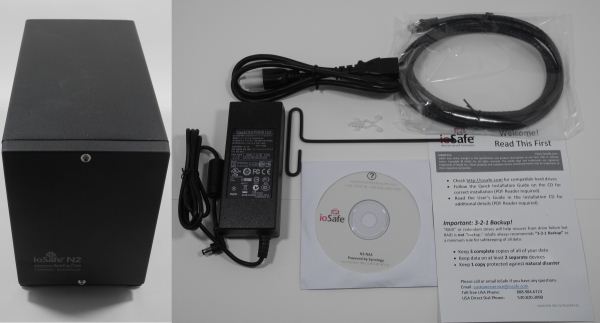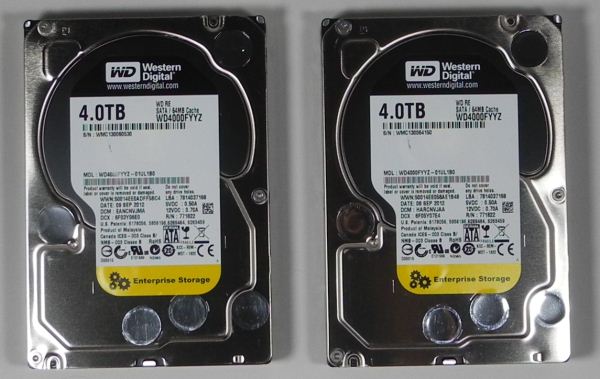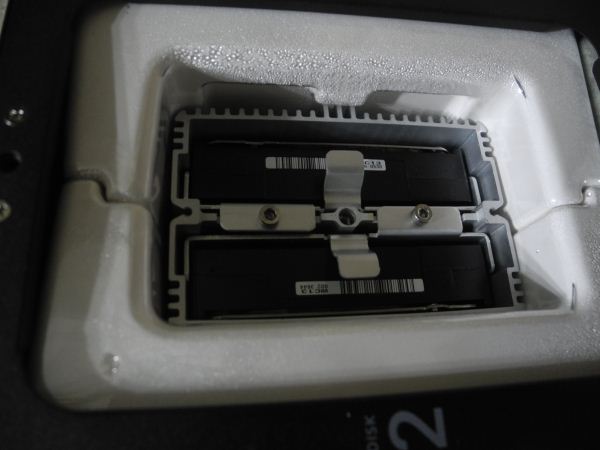ioSafe N2: A Disaster-Resistant Synology DS213
by Ganesh T S on March 4, 2013 12:00 PM ESTUnboxing and Hardware in Action
The striking aspect of the ioSafe N2 is, like the SoloPRO, its sheer weight. In addition to being fire and water-resistant, this makes it extremely unattractive as a target for theft during break-ins. There is a Kensington security slot, but the floor mount kit which was integrated in the SoloPRO is strangely made an optional accessory in this product. Unlike the SoloPRO, there is no curved front piece, but the industrial design is still excellent while making the internal disks user-accessible. All the external ports available in the DS213 are also available in the ioSafe N2. However, the locations of the ports have been modified to suit the new chassis.
The power switch / LED indicators, a USB 2.0 port and a SD card slot make up the bottom of the front face. The rear segment has two USB 3.0 ports, a 10/100/1000 Mbps RJ-45 port and a power adapter connector.
The Kensington slot also makes an appearance here. A ventilation fan takes up the remaining space on the rear panel. Along with the main unit, we also have a 72W DC power adapter, a 6 ft Cat 5 Ethernet cable, setup CD, a welcome guide and a specialized Allen wrench to use with the screws in the ioSafe N2.
One of the advances made by ioSafe with the N2 is the fact that the hard disks are user-accessible. This means that the end-user has visibility into the components which provide fire and water resistance to the disks. Upon removing the front face of the N2, we find the DataCast material on the rear side of the front panel as well as around the hard drive bays in the main chassis.
The hard drives are behind another layer of protection. This panel has a rubber gasket all along its perimeter to ensure that any water which makes it past the front panel doesn't get into the hard drive compartment.
Getting the hard disks out is just a matter of removing two more screws holding the hard drive panels in place. Our review unit came bundled with two Seagate ST3100524AS drives which are dual platter 1 TB drives. The hard drives are mounted on a solid aluminium base (great for conducting heat away from the HDDs) with screw slots on the sides for 3.5" drives. It would have been nice to have four screw slots on the base for 2.5" drives also.
One of the aspects to be noted by prospective consumers is the fact that the list of compatible HDDs is narrowed down from Synology's compatibility list. This is due to the fact that not all HDDs can keep data safe at the temperatures which the unit might be subjected to during a fire. The ioSafe N2 does provide fire resistance, but ioSafe did find that some of the HDDs were not reliable enough after being subjected to high temperatures. The compatibility list takes some searching to find out, and I have linked it here for convenience.
Even though the ioSafe N2 came bundled with Seagate HDDs, we decided to replace them with our standard test drives, the Western Digital RE 4TB version (WD4000FYYZ) in order to keep benchmark numbers consistent across different NAS units. The WD4000FYYZ is also in the compatibility list provided by ioSafe.
For the ioSafe N2, an updated version of the DataCast component is being used. This design allows for more water to be part of the mixture, and we can even see water droplets forming on the inside after operating the unit for a short time. The more water we have in the surrounding material, the better is the fire resistance.
We now move on to the benchmark numbers.



















26 Comments
View All Comments
Death666Angel - Wednesday, March 6, 2013 - link
Well, all I could find about the drives is that they are rated for operation between 5°C and 55°C. Not sure what ioSafe means.But I have to say, I find it hard to believe that any enterprise would subject their HDDs to non-climate-controlled rooms. So staying below 30°C environmental temperatures should not be a problem in any enterprise situation.
robb.moore - Monday, March 11, 2013 - link
That particular series of WD enterprise drives (FYYZ) runs hotter than most. Both Synology and ioSafe recommend a 30C operating environment in order to maintain 55C or lower on the drive PCB. Hope that helps!-Robb Moore
Robb Moore
CEO
ioSafe
random2 - Thursday, March 14, 2013 - link
I get your point although I'll be a great number of enterprise class drives are not installed in purpose built rooms serviced by hundreds of thousands of dollars worth of HVAC equipment.random2 - Wednesday, March 6, 2013 - link
*For the ioSafe N2, an updated version of the DataCast component is being used. This design allows for more water to be part of the mixture, and we can even see water droplets forming on the inside after operating the unit for a short time. The more water we have in the surrounding material, the better is the fire resistance.*Since this just seems to be so counter-intuitive to most of us working with electronics, can you shed a little more light on how ioSafe came up with this idea for cooling etc. I realize the actual drive housing must be hermetically sealed, but this is still pretty cool stuff.
ganeshts - Wednesday, March 6, 2013 - link
I had some coverage of the DataCast and other related components in the SoloPRO review: http://www.anandtech.com/show/5731/iosafe-solopro-... : DataCast is based on the final patent in that page (a super-saturated enclosure made of gypsum or similar material). Hope that answers your questions.random2 - Thursday, March 14, 2013 - link
Thank you Ganesh...Appreciate the link a great deal.Cheers.